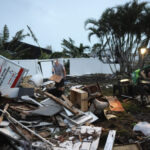As storms continue pummeling the Southland, Commissioner John Garamendi advised all Californians to be wary of weather-related dangers and urged homeowners to conduct a home inventory as soon as possible to ensure that their homes and possessions are properly covered. Garamendi also urged state consumers to review their insurance coverage on a regular basis, including supplemental insurance policies such as flood insurance.
“First and foremost, be safe – take heed of storm warnings and barricades,” said Garamendi. “It is also essential that you document all of your possessions before disaster strikes, because if you become a victim you’ll be asked to provide your insurance company with copies of bills, receipts or other documentation to support your claims.
“Dealing with a disaster at home can be a tremendously stressful time,” the Commissioner said. “Relying solely on your memory to inventory your assets is a mistake you can avoid.”
Be safe
Even after the rains have eased, the floodwaters have begun to recede, and after potential landslides have been deemed stable, remember:
When driving, do not go around a barricade or through a flooded roadway – barricades have been placed for one’s protection, as roads may still be closed because they have been damaged or are covered by water;
Keep listening to the radio for news about what to do, where to go, or places to avoid – additional flooding or flash flooding can still occur;
Delay unnecessary errands, but stay on firm ground if one must walk or drive in areas that have been flooded – moving water only six inches deep can sweep people off their feet, and standing water may be electrically charged from underground or downed power lines; and
If the car stalls in rapidly rising waters, get out immediately and climb to higher ground.
Inventory belongings
A complete household inventory list will provide: a permanent record of the home’s contents and their value; serial numbers listed for electronic items and appliances; and a good indication to the insured of whether or not current insurance coverage is adequate.
If possible, photograph or videotape household possessions. Pictures are helpful when an item is hard to describe on paper or if a purchase receipt cannot be obtained. Label each photograph with information about the item. If a camcorder is used, provide commentary of each item and date-stamp on the video.
Store a copy of the inventory in a safe-deposit box, work office or relative’s house, and include copies of any important documentation or receipts. The list should be updated semi-annually to ensure an accurate recording of the home’s contents. Sample property inventory lists are available from the California Department of Insurance Web site at www.insurance.ca.gov.
“Homeowners shouldn’t depend on their insurance companies to keep them informed of the need for additional coverage on a year to year basis, nor for complete information on how to best protect your assets,” said Garamendi. “If you had any type of property damage during these tremendous rainstorms, and require assistance with filing a claim, please call our Helpline at (800) 927-HELP.”
Consider flood insurance
In 1968, Congress created the National Flood Insurance Program (NFIP) in response to the rising cost of taxpayer funded disaster relief for flood victims and the increasing amount of damage caused by floods.
According to the Federal Emergency Management Agency (FEMA), flood insurance covers building and contents, and costs $500-$700 per year. The actual cost depends upon several factors, such as the region’s flood risk, year the structure was built, and type of structure insured (e.g., residential versus commercial, single-family versus multiple-family).
FEMA manages the NFIP, which makes federally backed flood insurance available to homeowners, renters, and business owners in communities participating in the NFIP.
Was this article valuable?
Here are more articles you may enjoy.

 Plane Crashes into San Diego Neighborhood, Setting Homes And Vehicles on Fire
Plane Crashes into San Diego Neighborhood, Setting Homes And Vehicles on Fire  Harvard Settles Lawsuit by Former Student Claiming Antisemitism
Harvard Settles Lawsuit by Former Student Claiming Antisemitism  Cyberattack Surge Creates Opportunity, Premium Rethink for Insurers
Cyberattack Surge Creates Opportunity, Premium Rethink for Insurers  Here Comes Another Busy Atlantic Hurricane Season, But Will It Be as Crazy as 2024?
Here Comes Another Busy Atlantic Hurricane Season, But Will It Be as Crazy as 2024? 